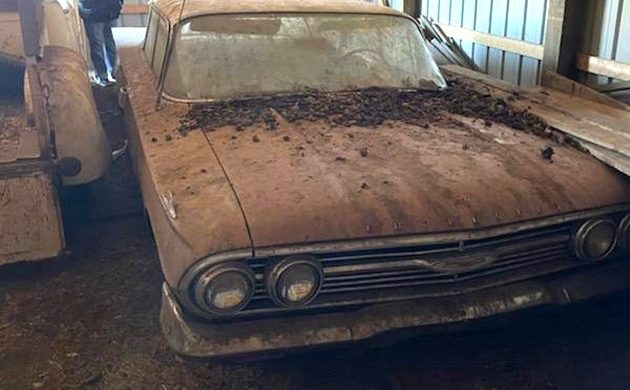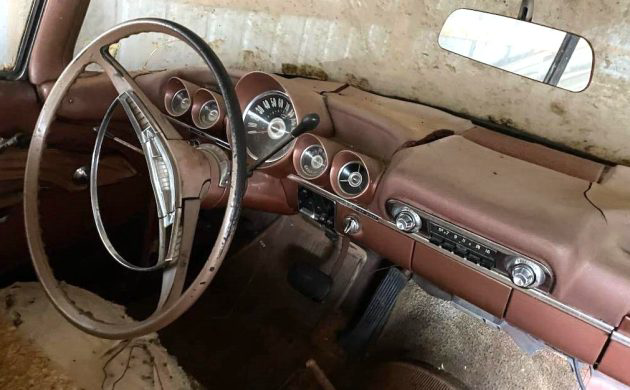After a radical styling redo in 1959, Chevrolet toned down its full-size cars a bit in 1960. The batwing tailfins were still there, but the “cats’ eye” taillights were replaced by circles and the front grillwork was less aggressive. The Bel Air continued as the mid-range offering, sandwiched between the Biscayne and Impala. The seller’s ’60 Bel Air Sport Sedan (aka 4-door hardtop) is in rough shape after sitting in a pole barn for as long as 40 years.
Even though the Bel Air wasn’t as snappy as the Impala, you had a range of body styles to choose from that were shared with the Impala. Like the Sport Coupe and Sport Sedan. The only exception was a convertible which was reserved for the upper tier. Though this Bel Air has a 2-speed Powerglide automatic transmission, the original buyer went the economy route with the basic 235 cubic inch inline-6 engine (135 hp).
The dormant Chevy is being sold as part of an estate. Little is known about its history and the condition of the vehicle suggests it may be better suited for parts as opposed to a restoration project. The tires are flat, so to move it some rollers will be needed (which might be helped by the spare wheels/tires in the trunk). While the body is mostly straight, the undercarriage has its issues including the floor pans which we’re told are rusted out.
There may not be much in the interior that would help with another project, though all the glass is said to be good. The seller thinks this was a two-owner car as the current family has owned the vehicle since 1966. It’s not known whether the engine is frozen or free. Located in the boonies south of Rapid City, South Dakota, the flat-top Chevy is available here on craigslist for $1,800. Project or parts or pass?





Remote ravine. Keep the hubcaps. Back to the earth.
Rescue the glass anyway
Looks like it could be savable if you’re
a more door lover like I am. Other than the floors, the car LOOKS solid but there might be rust lurking behind
what solid metal there might be. The
only real I’d have would be the frame.
If the frame is toast, then this car is
goin’ to the crusher. Most notable would be where the Panhard rod connects to the frame, and then to the floorboards. I do think that the 235 and PG tranny will be very easy to
revive given their simplicity and ease
of repair. And parts? No worries here
as you can still find most of what you
need at your local NAPA store. I’ve
always liked these cars and always
wanted one but life keeps getting in
my way. All I can do is hope.
I think Mortske needs parts from this car for his..LOL.
Rare does not automatically mean desirable or valuable. But, man, that has got to be one SUPER rare model there. This is the only 4-door hardtop in Bel Air trim, rather than the top-of-the-line Impala trim, that I have ever seen.
Add options like the padded dash, push button radio, automatic, full hubcaps, and fender birds, it really makes you wonder what was going through a person’s mind to want this sort of “upscale” car but without the Impala trim. They must have really not liked the side stripe on an Impala!
I’m not sure this car’s all that rare. The flat roof 4 door “Sport Sedan” (as the 4 door hardtop was called) was available in both Bel Air and Impala trims and found a combined 169,000 buyers in 60. The 4 door post far out sold (by over 300,000 units) the Sport Sedan, but it was available in all three trim levels. Back then you could order a car anyway you wanted it, making what was common then seem strange compared to today where all cars are equipped the same.
In 60 my mother had the Parkwood wagon twin to this car (Bel Air trim wagons were called Parkwood’s). Her’s was also Suntan Copper with an Adobe Beige roof, Powerglide, full wheel covers, an AM push button radio, but with a 283. My father also had a 60, but his was a Cascade Green 6 cylinder Biscayne 4 door post company car.
Not all cars back then were specially ordered. A lot of times dealers were just given cars to sell in various trim levels with different options and this was the luck of the draw. I’m not really a mordoor fan but ya gotta love that back window, now that’s stylin’ at its finest. But if this one has been sitting the dirt for 40 years there might not be much left to save. That’s a shame because this is a unique car to say the least.
Don’t forget the ones that bailed on the order, and the dealer was “stuck” with an oddly optioned car. I see what’s apparently “left over” for classic cars. All the good ones have been accounted for, and this is what’s left over. Sadly, I see no future for cars like this.
I agree with you Howard. You won’t find a young person today that has any interest in getting their hands dirty reviving a piece of our past. One of the kids I work with was out on a date and had a flat tire. Other than his embarrassment, he had to call AAA to come out and change it! I just
don’t know what this world is coming
to. I changed my first tire at 10 years
old and never looked back. Even in the Driver’s Ed classes my friends took in highschool, you had to know
basic auto repairs BEFORE you passed and got your license. And how do I know this you ask? I taught
that stuff in our Driver’s Ed classes for extra credit midway through my
Sophomore year in highschool. Seems that my Auto Shop teacher was impressed by my grades and the
fact I changed a tire for his wife and
daughter while on my way to a gig we
were playing in town that weekend. That may have gotten me points in class but not enough to date his daughter. Point is, if we don’t start
putting wrenches in the hands of young people now, our hobby is all
but finished. How do we do it? I dunno. It’s nearly impossible to get
their noses out of their phones and off of Facebook.
@Kenneth
How true, how true. I keep telling my Godson, LEARN A TRADE! people have gotten lazy af and will pay you good money to fix something simple. If you don’t do that, at least go to college for IT.
Use the front end and back end to make a shorty el camino like the one in the car shows!
One thing I’ve always liked about 1960s cars is the fact that the same car came in several different body styles. 2-dr hardtop, 4-dr hardtop, 2-dr pillard, 4-dr pillard, 2-dr convertible, and the crue de ta, several different rooflines. Something we haven’t seen in decades. Although, I have to admit, something I’ve always hated was General Motors “flat top” roofline. It only came in 4-dr hardtop but to me, ugly as sin! The late 50s early 60s the cars were flashy styling, even the submodels, with “bubble” tops and “fastback” rooflines, but the GM flat top was square and ugly. I’m sure there are people who really like the flat top styling, but all this is, as always, JMO. And ya’ll know I have lots.
My father had a 1960 Cadillac flat top. IMO the 2-dr and 4-dr coupe and sedan were gorgeous. The flat top, not so much. It just looked odd, like they chopped the roof off of another make and stuck it on the GM car.
Personally I’ve always liked the flat tops, especially the 1959 Pontiac Catalina. My parents’ first new car was a 1960 Catalina Safari and I always thought it would have looked better as a hardtop wagon, but GM kept that to Buick and Olds and then just ’57 and ’58 I believe.
Car is worth saving…you see very few on the road, car venues etc. not the norm.
The car looks pretty solid to me. Rocker panels , quarter panels , doors, trunk interior have no signs of serious rust. A dry dirt floor is kind to a vehicle.
Plus it looks complete.
Sure there much work to be done, but the bones look solid.
Probably a great deal for someone to take on as a project.
Don’t be scared of a little dirt.
Hi Angel! Long time no see. Love it or hate it, this car could be saved–and
I wish I was the one doing it. Such an
easy project to do that it reminds me of the stuff Dad and I did in the late ’60s before I started playing music. We’d watch the paper for cheap cars for sale, and then go get the ones that
would need very little to make them run. I guess the Midwest was Chevy
country as we saw a lot of these cars
for sale and dirt cheap too! Seems like that’s all we bought to repair back
then. The hardest one we did was the
time we put a 235 into a ’50 Fleet line
2-door fastback in ’68. It wasn’t the
swap that was difficult, it was doing the job without an engine hoist. Who
ever said that you could use a child’s
Swing set is full of hot air. We had to
Replace my kid sister’s unit after it
folded up while we were putting the
engine into the car! But a trip to Weaver’s Rent All for a proper hoist
fixed the problem just fine. Just check all the boxes when you bring ‘er
Back to life and you’ll be okay
…And yeah, we did sell some of them
to the partitioners of the church I told
you about earlier. Think we might’ve
sold one of these to a young couple
as a second car about that time. After that, people would ask us if we
had any other cars for sale and how much we were asking for them. We
sold most of them between $100-$150 to make them affordable.
Great fun, great times too!
Hey Kenneth,
Always a pleasure to hear from you. Not sure if you were around at the time but I posted some time ago that my father did the same thing, buy’em cheap, fix’em up, sell’em for a small profit. Only he did it with ’49, ’50, and mostly ’51 & ’52 Chevrolets. Some Pontiacs. By the late 1960s he didn’t do it too much. Guess by then you couldn’t get a car for $10. I never was involved with that. I just played in the cars and sometimes stole the trunk or hood ornaments. I had quite a collection.